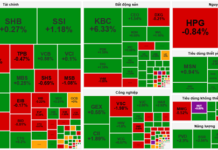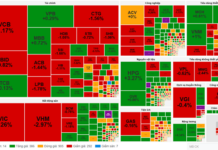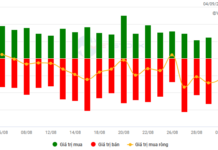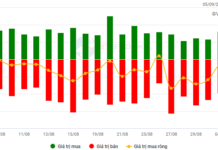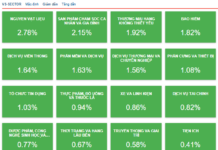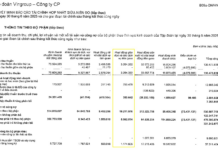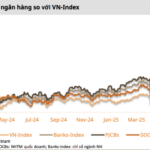In the first two months of 2024, the USD Index (DXY) increased by 1.89%, from 101.89 to 103.82. At one point, DXY reached the threshold of 105 (on February 13, 2024), before cooling down.
Domestically, the central exchange rate increased by 0.65% in the first two months, from 23,848 VND/USD on January 2, 2024, to 24,002 VND/USD on February 29, 2024. The strongest increase occurred during the Lunar New Year period (from January 18 to January 29, 2024). In the first half of February, the central exchange rate was mainly adjusted downward by the State Bank of Vietnam. After the Tet holiday, the central exchange rate continuously increased from February 23 to February 27 (24,014 VND/USD) and then cooled down.
According to the update from VnEconomy, the USD price at commercial banks increased by 1.35% since the beginning of the year. Specifically, the USD/VND exchange rate at commercial banks has been increasing significantly since the second half of February. On February 26, the exchange rate at commercial banks reached the highest level since the beginning of the year, with buying and selling prices of 24,470 VND/USD and 24,840 VND/USD respectively. On February 29, the listed buying prices at the banks range from 24,450 VND/USD to 24,820 VND/USD.
Meanwhile, the free USD rate increased by nearly 3% in the first two months of 2024, from 24,700 VND/USD to 25,430 VND/USD (selling price).

According to experts, the exchange rate may face high pressure in the first quarter due to significant differences in the monetary policies of the FED and the State Bank of Vietnam.
DXY is still anchored at a high level while the market awaits inflation data from the US and EU on the evening of February 29, 2024 (Vietnam time). Preliminary forecasts indicate that inflation may accelerate in the US while deflation may occur in the European region. This opens up the possibility of earlier interest rate cuts from the European central bank compared to the US, helping the USD to strengthen further. FED Chair in Boston, Susan Collins, said last night (February 28) that the agency may have to start cutting interest rates by the end of this year.
Meanwhile, FED Chair in New York, John Williams, continued to affirm that even though there is still a gap to reach the 2% inflation target of the FED, the opportunity to cut interest rates this year depends on US economic data in the coming time.
Total registered foreign investment in Vietnam as of February 20, 2024, including: Newly registered capital, adjusted registered capital, and value of capital contribution, purchasing shares of foreign investors reached nearly $4.29 billion, up 38.6% compared to the same period of the previous year.
The actual foreign direct investment in Vietnam in the first two months of 2024 is estimated to reach $2.8 billion, up 9.8% compared to the same period of the previous year.
General Statistics Office.
Meanwhile, Vietnam’s current monetary policy priority is focused on supporting growth.
The VND – USD interest rate gap is currently at a negative level of about 2.1% – 2.4%/year for maturities below 1 month, which can stimulate interest rate differentials business activities, exerting pressure on the exchange rate.
In the interbank market, overnight VND interest rate (the maturity period accounts for 90% of transactions) stayed below 1%/year in January. Moving to February 2024, the overnight VND interest rate on the interbank market adjusted sharply. Accordingly, on February 6, this rate reached 2.38%/year and then decreased to 1.04%/year on February 16, 2024.
In the second half of February, the overnight VND interest rate in the interbank market reached 4.14%/year (on February 21) – the highest level in 5 months. However, after that, the overnight VND interest rate gradually decreased to 3.32% on February 27, 2024.
However, interest rate fluctuations in the interbank market are weaker for longer maturities. Thus, the average interbank interest rates for the 2-week and 1-month maturities on February 27, 2024 were 3.01%/year and 2.91%/year respectively. Interest rates for maturities of 3-9 months in the interbank market did not fluctuate much in February 2024.
Parallel to the market trend, the State Bank of Vietnam has reactivated money pumping operations through collateralized lending on the open market with a larger scale than insignificant scale in the previous month. In the week of February 19 to February 23, the State Bank of Vietnam offered bids for 7-day maturities with a total value of 31,000 billion VND, however, only 6,037.51 billion VND was awarded with an interest rate of 4.0%/year. In both sessions with winning members (February 20 and February 21), the number of bidding participants and winning members was only one member.
The above developments indicate that there is a phenomenon of liquidity shortages at some banks before and after the Lunar New Year holiday. However, experts believe that this is not a cause for concern, and systemic liquidity can return to normal in March 2024 based on the following grounds: (i) overnight borrowing rates are declining, (ii) the liquidity injection scale of the State Bank of Vietnam is low in terms of both volume and the number of participants in collateralized lending on the open market, (iii) the interest rate fluctuation for longer maturities is not unusual.
According to the General Statistics Office, in February 2024, the total export and import turnover of goods is estimated at $48.54 billion, down 25.8% compared to the previous month and down 1.8% compared to the same period last year. In the first two months of 2024, the total export and import turnover of goods is estimated at $113.96 billion, up 18.6% compared to the same period last year, in which exports increased by 19.2% and imports increased by 18%. The trade balance of goods has a surplus of $4.72 billion (compared to a surplus of $3.5 billion in the same period last year). Specifically, the domestic economic area has a trade deficit of $3.53 billion, and the area with foreign investment (including crude oil) has a trade surplus of $8.25 billion.

